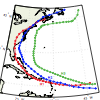Similarity of trajectories taking into account geographic context
Keywords:
movement data, geographic context, spatiotemporal analytics, similarity measures, trajectory analysis, modeling context, environmental factors, Fréchet distance, Hausdorff distance, equal time distanceAbstract
The movements of animals, people, and vehicles are embedded in a geographic context. This context influences the movement and may cause the formation of certain behavioral responses. Thus, it is essential to include context parameters in the study of movement and the development of movement pattern analytics. Advances in sensor technologies and positioning devices provide valuable data not only of moving agents but also of the circumstances embedding the movement in space and time. Developing knowledge discovery methods to investigate the relation between movement and its surrounding context is a major challenge in movement analysis today. In this paper we show how to integrate geographic context into the similarity analysis of movement data. For this, we discuss models for geographic context of movement data. Based on this we develop simple but efficient context-aware similarity measures for movement trajectories, which combine a spatial and a contextual distance. These are based on well-known similarity measures for trajectories, such as the Hausdorff, Fréchet, or equal time distance. We validate our approach by applying these measures to movement data of hurricanes and albatross.

Downloads
Published
Issue
Section
License
Copyright (c) 2014 Maike Buchin, Somayeh Dodge, Bettina Speckmann

This work is licensed under a Creative Commons Attribution 4.0 International License.
Articles in JOSIS are licensed under a Creative Commons Attribution 3.0 License.
